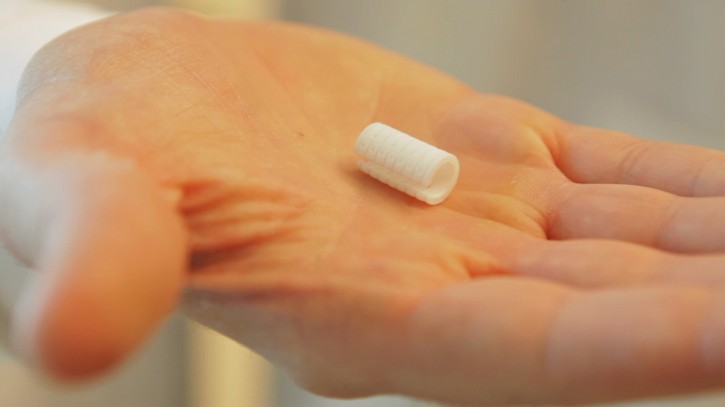 Youngstown, OH – In a medical first, doctors used plastic particles and a 3-D laser printer to create an airway splint to save the life of a baby boy who used to stop breathing nearly every day.
Youngstown, OH – In a medical first, doctors used plastic particles and a 3-D laser printer to create an airway splint to save the life of a baby boy who used to stop breathing nearly every day.
Subscribe to our Daily Roundup Email
It’s the latest advance from the booming field of regenerative medicine, making body parts in the lab.
In the case of Kaiba (KEYE’-buh) Gionfriddo, doctors didn’t have a moment to spare. Because of a birth defect, the little Ohio boy’s airway kept collapsing, causing his breathing to stop and often his heart, too. Doctors in Michigan had been researching artificial airway splints but had not implanted one in a patient yet.
In a single day, they “printed out” 100 tiny tubes, using computer-guided lasers to stack and fuse thin layers of plastic instead of paper and ink to form various shapes and sizes. The next day, with special permission from the Food and Drug Administration, they implanted one of these tubes in Kaiba, the first time this has been done.
Suddenly, a baby that doctors had said would probably not leave the hospital alive could breathe normally for the first time. He was 3 months old when the operation was done last year and is nearly 19 months old now. He is about to have his tracheotomy tube removed; it was placed when he was a couple months old and needed a breathing machine. And he has had not had a single breathing crisis since coming home a year ago.
“He’s a pretty healthy kid right now,” said Dr. Glenn Green, a pediatric ear, nose and throat specialist at C.S. Mott Children’s Hospital of the University of Michigan in Ann Arbor, where the operation was done. It’s described in Thursday’s New England Journal of Medicine.
Independent experts praised the work and the potential for 3-D printing to create more body parts to solve unmet medical needs.
“It’s the wave of the future,” said Dr. Robert Weatherly, a pediatric specialist at the University of Missouri in Kansas City. “I’m impressed by what they were able to accomplish.”

So far, only a few adults have had trachea, or windpipe transplants, usually to replace ones destroyed by cancer. The windpipes came from dead donors or were lab-made, sometimes using stem cells. Last month, a 2-year-old girl born without a windpipe received one grown from her own stem cells onto a plastic scaffold at a hospital in Peoria, Ill.
Kaiba had a different problem — an incompletely formed bronchus, one of the two airways that branch off the windpipe like pant legs to the lungs. About 2,000 babies are born with such defects each year in the United States and most outgrow them by age 2 or 3, as more tissue develops.
In severe cases, parents learn of the defect when the child suddenly stops breathing and dies. That almost happened when Kaiba was 6 weeks old at a restaurant with his parents, April and Bryan Gionfriddo, who live in Youngstown, in northeast Ohio.
“He turned blue and stopped breathing on us,” and his father did CPR to revive him, April Gionfriddo said.
More episodes followed, and Kaiba had to go on a breathing machine when he was 2 months old. Doctors told the couple his condition was grave.

“Quite a few of them said he had a good chance of not leaving the hospital alive. It was pretty scary,” his mother said. “We pretty much prayed every night, hoping that he would pull through.”
Then a doctor at Akron Children’s Hospital, Marc Nelson, suggested the experimental work in Michigan. Researchers there were testing airway splints made from biodegradable polyester that is sometimes used to repair bone and cartilage.
Kaiba had the operation on Feb. 9, 2012. The splint was placed around his defective bronchus, which was stitched to the splint to keep it from collapsing. The splint has a slit along its length so it can expand and grow as the child does — something a permanent, artificial implant could not do.
The plastic is designed to degrade and gradually be absorbed by the body over three years, as healthy tissue forms to replace it, said the biomedical engineer who led the work, Scott Hollister.
Green and Scott Hollister have a patent pending on the device and Hollister has a financial interest in a company that makes scaffolds for implants.
Dr. John Bent, a pediatric specialist at New York’s Albert Einstein College of Medicine, said only time will tell if this proves to be a permanent solution, but he praised the researchers for persevering to develop it.
“I can think of a handful of children I have seen in the last two decades who suffered greatly … that likely would have benefitted from this technology,” Bent said.
___
Online:
Journal: http://www.nejm.org

Medicine and science saving lives!
Thank you science and technology for this amazing advance!!
medicine and creativity -thinking outside the box -instead of standard revenue generation -saving lives.
Ma godlu maaseichu Hashem.
Horray for a good story from Youngstown on all places such as Vos Iz Neias!!!! I spent 5 years in Youngstown and it was a gingerly great time of great beginnings in my career! I hope to someday see more good yidden in that town!
Lets hope senator Schumer doesn’t ban all 3d printers, and that more lives can be saved!